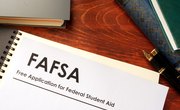The Free Application for Federal Student Aid, or FAFSA, is an application that families or individuals complete to apply for federal grants, loans or work-study funds for college tuition and fees. The application process is free, and it is managed though the U.S. Department of Education.
The U.S. Department of Education provides approximately $150 billion in student assistance each year; however, it is important to understand how your FAFSA eligibility is determined. Your eligibility for assistance, and how much assistance you qualify for, is determined by your Expected Family Contribution.
Your Expected Family Contribution (EFC) will determine eligibility and how much assistance you can get. Eligibility will always depend on your current financial status, and your current financial needs based on the information you submit during the application process. Applicants may either be eligible for student grants, which do not have to be paid back, or student loans, which do require repayment.
What Is EFC?
In order to be eligible for student aid, you must first determine your EFC. Your EFC is an index score and will be used to determine your level of financial need. The EFC will then determine how much financial aid you are eligible for.
The EFC is comprised of you and your family’s taxable income, assets and any other benefits anyone receives. This may include social security or unemployment benefits. It also takes into consideration the cost of attendance, your family’s size and the number of family members that will be attending school.
What EFC Means
Once calculated, the EFC will essentially mean whether or not you are eligible for federal student aid. Eligible applicants may receive Pell Grants or subsidized student loans, but ineligible applicants may apply for scholarships or non-subsidized loans. If you are eligible, the EFC will determine exactly how much financial aid you can get.
FAFSA EFC Chart
The EFC is used to determine your eligibility for federal student aid. There is a set of specific calculations used to determine your eligibility. EFC is calculated by taking the Cost of Attendance (COA) and subtracting the EFC.
COA – EFC = Eligibility Determination
The numbers are essentially placed into the FAFSA EFC chart, and the calculations determine eligibility. Calculations include adding up the parents’ income and assets, along with the student’s income and assets. This total number is then subtracted from the total cost of attendance.
You may be wondering what is a good EFC score. When it comes to EFC, the lower the better. The more income and assets the student and parents have, obviously the less aid the student will be eligible for.
Good EFC Score
A “good” EFC score, meaning that you are eligible for the most aid is, zero. Generally, the lower your EFC score, the more aid you are eligible for. Additionally, students with a zero EFC score will also be eligible for different types of aid, specifically grants that do not need to be paid back.
It is important to keep in mind that no matter how low the EFC score, it’s rare to get everything paid for. Most colleges and universities will offer the maximum amount a student is eligible for, it’s rare that the amount will cover 100 percent of tuition and fees. In this case, students may need to seek out additional sources of funding.
Improve Your EFC
It is possible to improve your EFC score. Improving or lowering your EFC will increase your eligibility for financial aid. Consider improving your EFC score by paying off large debts. Always delay big ticket purchases such as a car until after you have completed the FAFSA application process.
Related Articles
Writer Bio
Melanie Forstall has a doctorate in education and has worked in the field of education for over 20 years. She has been a teacher, grant writer, program director, and higher education instructor. She is a freelance writer specializing in education, and education related content. She writes for We Are Teachers, School Leaders Now, Classroom, Pocket Sense, local parenting magazines, and other professional academic outlets. Additionally, she has co-authored book chapters specializing in providing services for students with disabilities.










